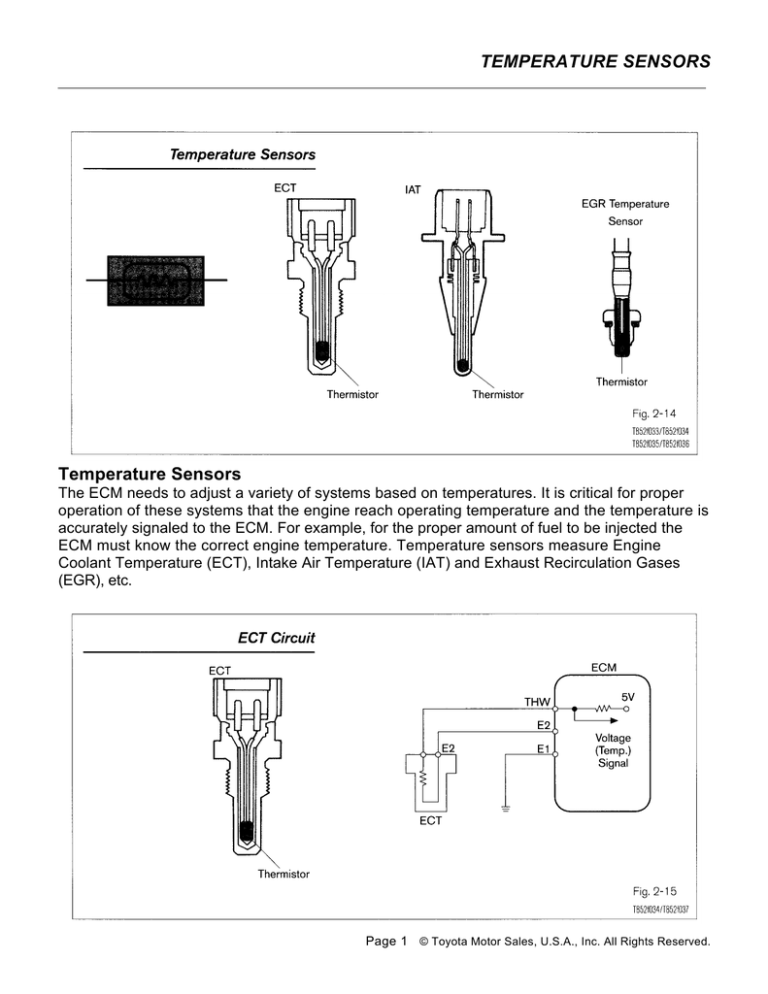
TEMPERATURE SENSORS
Temperature Sensors
The ECM needs to adjust a variety of systems based on temperatures. It is critical for proper
operation of these systems that the engine reach operating temperature and the temperature is
accurately signaled to the ECM. For example, for the proper amount of fuel to be injected the
ECM must know the correct engine temperature. Temperature sensors measure Engine
Coolant Temperature (ECT), Intake Air Temperature (IAT) and Exhaust Recirculation Gases
(EGR), etc.
Page 1 © Toyota Motor Sales, U.S.A., Inc. All Rights Reserved.
TEMPERATURE SENSORS
Engine Coolant Temperature (ECT) Sensor
The ECT responds to change in Engine Coolant Temperature. By measuring engine coolant
temperature, the ECM knows the average temperature of the engine. The ECT is usually
located in a coolant passage just before the thermostat. The ECT is connected to the THW
terminal on the ECM.
The ECT sensor is critical to many ECM functions such as fuel injection, ignition timing, variable
valve timing, transmission shifting, etc. Always check to see if the engine is at operating
temperature and that the ECT is accurately reporting the temperature to the ECM.
Intake Air Temperature (IAT) Sensor
The IAT detects the temperature of the incoming air stream. On vehicles equipped with a MAP
sensor, the IAT is located in an intake air passage. On Mass Air Flow sensor equipped
vehicles, the IAT is part of the MAF sensor. The IAT is connected to the THA terminal on the
ECM. The IAT is used for detecting ambient temperature on a cold start and intake air
temperature as the engine heats up the incoming air.
NOTE: One strategy the ECM uses to determine a cold engine start is by comparing the ECT
and IAT signals. If both are within 8'C (15'F) of each other, the ECM assumes it is a cold start.
This strategy is important because some diagnostic monitors, such as the EVAP monitor, are
based on a cold start.
Page 2 © Toyota Motor Sales, U.S.A., Inc. All Rights Reserved.
TEMPERATURE SENSORS
Exhaust Gas Recirculation (EGR) Temperature Sensor
The EGR Temperature Sensor is located in the EGR passage and measures the temperature
of the exhaust gases. The EGR Temp sensor is connected to the THG terminal on the ECM.
When the EGR valve opens, temperature increases. From the increase in temperature, the
ECM knows the EGR valve is open and that exhaust gases are flowing.
Page 3 © Toyota Motor Sales, U.S.A., Inc. All Rights Reserved.
TEMPERATURE SENSORS
ECT, IAT, & EGR Temperature Sensor Operation
Though these sensors are measuring different things, they all operate in the same way. From
the voltage signal of the temperature sensor, the ECM knows the temperature. As the
temperature of the sensor heats up, the voltage signal decreases. The decrease in the voltage
signal is caused by the decrease in resistance. The change in resistance causes the voltage
signal to drop.
The temperature sensor is connected in series to a fixed value resistor. The ECM supplies 5
volts to the circuit and measures the change in voltage between the fixed value resistor and the
temperature sensor.
When the sensor is cold, the resistance of the sensor is high, and the voltage signal is high. As
the sensor warms up, the resistance drops and voltage signal decreases. From the voltage
signal, the ECM can determine the temperature of the coolant, intake air, or exhaust gas
temperature.
The ground wire of the temperature sensors is always at the ECU usually terminal E2. These
sensors are classified as thermistors.
Temperature Sensor Diagnostics
Temperature sensor circuits are tested for:
• opens.
• shorts.
• available voltage.
• sensor resistance.
The Diagnostic Tester data list can reveal the type of problem. An open circuit (high resistance)
will read the coldest temperature possible. A shorted circuit (low resistance) will read the
highest temperature possible. The diagnostic procedure purpose is to isolate and identify the
temperature sensor from the circuit and ECM.
High resistance in the temperature circuit will cause the ECM to think that the temperature is
colder than it really is. For example, as the engine warms up, ECT resistance decreases, but
unwanted extra resistance in the circuit will produce a higher voltage drop signal. This will most
likely be noticed when the engine has reached operating temperatures. Note that at the upper
end of the temperature/resistance scale, ECT resistance changes very little. Extra resistance in
the higher temperature can cause the ECM to think the engine is approximately 20'F = 30'F
colder than actual temperature. This will cause poor engine performance, fuel economy, and
possibly engine overheating.
Page 4 © Toyota Motor Sales, U.S.A., Inc. All Rights Reserved.
TEMPERATURE SENSORS
Solving Open Circuit Problems
A jumper wire and Diagnostic Tester are used to locate the problem in an open circuit.
Page 5 © Toyota Motor Sales, U.S.A., Inc. All Rights Reserved.
TEMPERATURE SENSORS
Solving Shorted Circuit Problems
Creating an open circuit at different points in the temperature circuit will isolate the short. The
temperature reading should go extremely low (cold) when an open is created.
Page 6 © Toyota Motor Sales, U.S.A., Inc. All Rights Reserved.
TEMPERATURE SENSORS
ASSIGNMENT
NAME: ___________________________
1. List the three types of temperature sensors used and explain the function of each?
2. Temperature sensors are actually ______________?
3. Draw a sample temperature sensor circuit. (Label all parts)
4. The ECT us used by the computer to control what functions?
5. What PCM strategy is used when both the IAT and ECT are within 15’F of each other?
6. Temperature sensors are tested for:
7. Describe the procedure of testing a temperature sensor.
Page 7 © Toyota Motor Sales, U.S.A., Inc. All Rights Reserved.


